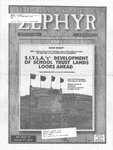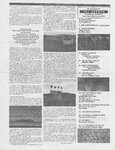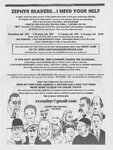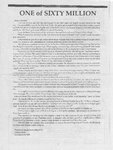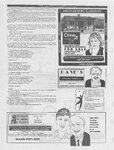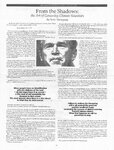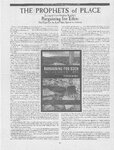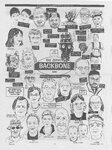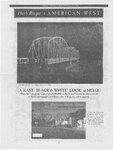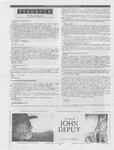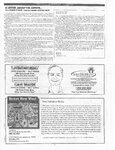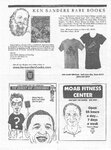| OCR Text |
THE ZEPHYR] DECEMBER THE 2008-JANUARY 2009 of PLACE PROPHETS Excerpted from Stephen obit S argaining fofor Eden: The Fight for the Last Open ae in America his office Grant found the deed to an apple orchard in Washington that he’d won in one of his business deals and forgotten. It was all he had left. And so the Trimbles moved to Dreams lie under the hardpan surface of the desert West, hidden beneath an alkaliwhite crust. Stories underlie meadows; visions sleep in mountains; every place name carries lives within it. And from these —— and places ies the stories of generations Toppenish, a small town in the Yakima Valley. My father was born in Westhope, North Dakota. West and hope—the destinies and desires of thousands of dreamers caught up by the frontier distilled in two words. The town had existed for just thirteen years when “Doc Charley” Durnin delivered tiny, premature Donald Eldon Trimble and kept him alive by incubating him in a shoebox placed _in the office oven. March 6, 1916. Baby-Don’s parents, my grandparents, were authentic pioneer offspring. I heard their stories-as a child, and they es the opening of the West close. My bea hainds ae: Seiffert was one of the first white children—as the family stories always put it—born in that part of North Dakota in 1892. The Seifferts, Alsatian and Scotch immigrants, had made their way west through Canada, from Ontario to Manitoba, finally crossing south over the line to North Dakota in the 1880s. One of the family homesteads lay along the curl of Antler Creek within sight of the international boundary, a little stream that ambled between the two coun- In my childhood my paternal grandparents lived at the far west of our family space in the Yakima Valley in Washington. Here, in Toppenish, where my father had grown up, my father’s parents and‘ my ena s two. brothers and three sisters all lived within a few blocks of each other. The Trimbles had brought their stories with them when they moved from North Dakota. They were townspeople now, but they stayed close, interdependent, with the special affinity of those with a shared past—in their case the boom times back in Dakota. They would spread their Adirondack chairs in a backyard circle and sip iced tea, reliving life on the farms and surrounding prairie as an adventure, reliving the golden memories of their youth. Those Toppenish backyards contained some of my first wild places. The great evergreen tree that sheltered my grandfather's fishing boat, where I tries through box elder, elm, and ash thickets—past a rock farmhouse, aplank bridge, a springhouse smell- ing of butter and cream. Another branch of the Seiffert would bull roused his herd when he spotted their carriage from his lookout post on a hint of a hill—and on that My grandfather's Trimble forebears followed the hide in sharp-needled shade. A cement- lined fishpond. A dusty alley with hollyhocks and bumblebees. These are my elemental, fun- family chose a spot along Antler Creek in 1883 when they spooked a remnant herd of buffalo. The guard rise they built their house. : Unlike the tragic arcs of the boomers dramatized in Wallace Stegner’ s books, Grant Trimble put down roots in Toppenish. Giving up his wilder dreams, he transformed the Trimbles into settlers — piderss = for the pmaind? of the iwentel ay of my family. damental memories, from a time almost beyond memory. I can tell just how primal because when oe - 7 t Fork Maat Je eae American frontier westward from Alleghany County, Maryland, in pre-Revolutionary days—to Ohio, lowa, and North Dakota. Branches of that clan reach back to the early Europeans’ voyages to New England. My great-grandfather Grant Trimble was the star of many of the family stories, was a terrific character: the flawed patriarch. He came west when he drove horses from Iowa to North Dakota, made a profit, and decid- ee ae Smiles I recall those explorations, diving deep into that ancient lizard brain where awareness begins with scent, I smell that dust and those pine needles as much as see them. The Trimbles’ experience of moving with the frontier was classically western. They may not have trapped beaver with the mountain men, but my great-uncles’ stories of hunting and fishing in North Dakota, the photographs of the family farm that freeze moments of my father’s earliest ed to stay. He platted and built the town of Richburg, North Dakota, in 1898, and an old family photograph shows his center of operations, a storefront for “Trimble’s Dry Goods Department” and “Trimble’s State Bank.” Little-America-style promotional signboards completely covered the building: “The Greatest Sale of Modern Times.” “The Wonder of the Age.” “They childhood, all tied me to The West, as home and myth, and to the nineteenth century colonization of the frontier and the great dividing of the continent into private and public realms. From Toppenish the Trimbles looked up to the western horizon every day to see if their moun- Kan’t Ketch Up.” “Fat Bargains.” “A Happy Shopping Place.” tains were visible—the sublime glacier-covered half rounds of Mount Adams and Mount Rainier. When the railroad bypassed him five years later he platted his brother’s farm, which happened to lie next to the railhead, and competed for sales by offering land at a fraction of the price of the railroad’s lots. The These were ever-present, hovering presences in their lives. My father climbed these mountains as a boy with the Boy Scouts and the Mountaineers Climbing Club. He Great Northern succumbed to his bluff, lowered their took road trips with his pals, saving his prices, and gave him a major portion of the lots in the money for gas so that he could see the saguaros new in the Sonoran town. Great-grandfather Trimble gleefully put -Richburg on wagons, building by building, and moved his frontier mini-development to the new railhead town of Westhope a mile and a half away. His oldest son, my grandfather Donald Enoch Trimble, was the first graduate of Westhope High School. (There were only two graduates that spring day in 1909, Trimble and Warner, and commencement was alphabetical.) In Wallace Stegner’s pithy words, the families who came west at this time were “boomers” or “stickers.” The boomers followed their dreams, booming and busting but always refusing to knuckle under to the reality of the dry West, always refusing to stay put and “stick.” Grant Trimble was a boomer. Desert, the Grand Canyon, the Great Southwest. When his family visited North Dakota, they detoured to Glacier National Park and to Yellowstone. He loved mountains, he loved the outdoors, and he stud- ied geology in college so that he could work outside—putting himself through school with stints as a hard-rock miner. This was the homestead era as well, and the Trimbles and the Seifferts claimed land for After World War II deprived him of his home landscape during a three-year exile in the South Pacific theater, my father was delighted to be back on the road in the West. He had heard that the United States Geological Survey (USGS) was hiring in Denver. At thirty, footloose and in need of a job, this sounded good to him. He moved, within two years married the office clerk-typist— oe mother—and spent more than thirty years as a USGS field geologist. their own. Public land was simply unhomesteaded land, and that’s where the men went duck hunting in the marshes, where young Don Trimble and Ruby Seiffert courted by hooking up the sidecar to my Grandpa’s Indian motorcycle and bumping over the Turtle scientists did field work in summer in wild country all over the West, then returned home Dad and his fellow geologists and their wives were my primary childhood circle. These to Denver in winter to work out the meaning of their notes and maps, publishing their theories as monographs. Their work verged on exploration and was less than ny years after John Wesley Powell had worked in some of the same places. Mountains to Lake Metigoshe for picnics. For a time, Grant Trimble avoided the bust; he even served as a state senator. The bust came in 1912, when he lost all his money in the wheat futures market. While cleaning out 20 |
